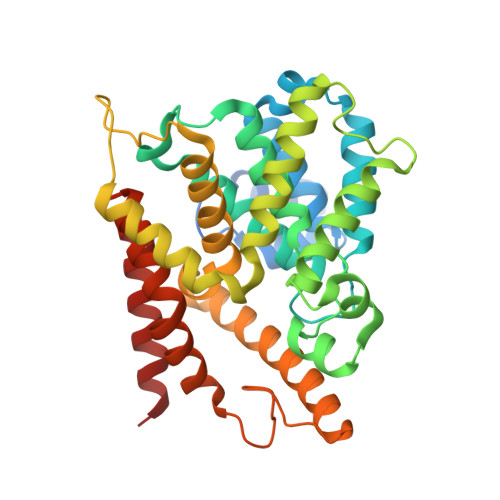Structure-Aided Identification and Optimization of Tetrahydro-isoquinolines as Novel PDE4 Inhibitors Leading to Discovery of an Effective Antipsoriasis Agent.
Zhang, X., Dong, G., Li, H., Chen, W., Li, J., Feng, C., Gu, Z., Zhu, F., Zhang, R., Li, M., Tang, W., Liu, H., Xu, Y.(2019) J Med Chem 62: 5579-5593
- PubMed: 31099559
- DOI: https://doi.org/10.1021/acs.jmedchem.9b00518
- Primary Citation of Related Structures:
6IM6, 6IMB, 6IMD, 6IMI, 6IMO, 6IMR, 6IMT, 6IND, 6INK, 6INM - PubMed Abstract:
Psoriasis is a common, chronic inflammatory disease characterized by abnormal skin plaques, and the effectiveness of phosphodiesterase 4 (PDE4) inhibitor to lessen the symptoms of psoriasis has been proved. Aiming to find a novel PDE4 inhibitor acting as an effective, safe, and convenient therapeutic agent, we constructed a library consisting of berberine analogues, and compound 2 with a tetrahydroisoquinoline scaffold was identified as a novel and potent hit. The structure-aided and cell-based structure-activity relationship studies on a series of tetrahydro-isoquinolines lead to efficient discovery of a qualified lead compound (16) with the high potency and selectivity, well-characterized binding mechanism, high cell permeability, good safety and pharmacokinetic profile, and impressive in vivo efficacy on antipsoriasis, in particular with a topical application. Thus, our study presents a prime example for efficient discovery of novel, potent lead compounds derived from natural products using a combination of medicinal chemistry, biochemical, biophysical, and pharmacological approaches.
Organizational Affiliation:
CAS Key Laboratory of Receptor Research, State Key Laboratory of Drug Research, Drug Discovery and Design Center, Laboratory of Immunopharmacology , Shanghai Institute of Materia Medica, Chinese Academy of Sciences , Shanghai 201203 , China.


















